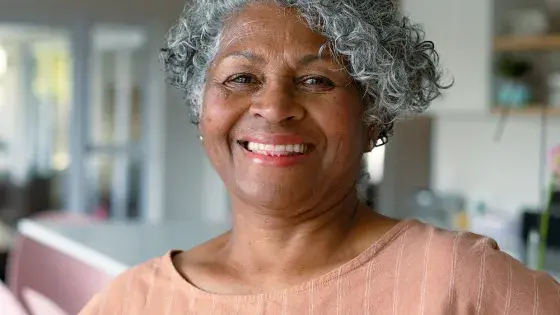Together we can work towards a day where cervical cancer is a thing of the past, but to do so, every women and person with a cervix needs to have access to the right information and support to help prevent the cancer. When cervical cancer is found early, it is highly treatable and associated with long survival and good quality of life.
So, what is cervical cancer?
Cervical cancer is a cancer in the cervix, the opening of the womb from the vagina.
It is possible for anyone with a cervix (women, trans men, people who are non-binary who were assigned female at birth, and cis gender women) of any age to develop cervical cancer. Traditionally the condition mainly affects those who are sexually active between the ages of 30 and 45 years, however data from Cancer research UK is demonstrating the peak age of incidents has reduced to 25 to 29 years of age. It accounts for 2% of all new cancer cases.
What are the symptoms?
Cancer of the cervix often has no symptoms in its early stages and may only be detected after abnormal cervical screening (smear test). Symptoms can be subtle and may be attributed to other benign gynaecological conditions, or there may be no symptoms.
When symptoms are present the most common ones are:
- abnormal vaginal bleeding
- vaginal bleeding between periods
- vaginal bleeding after sex
- vaginal bleeding after the menopause
Other symptoms may include painful sexual intercourse and abnormal vaginal discharge.
Abnormal vaginal bleeding does not mean that you have cervical cancer, but you should see a GP as soon as possible to get it checked out. If a GP thinks that you might have cervical cancer, you should be referred to see a specialist within two weeks.
What increases your risk of cervical cancer?
- Human Papilloma virus (HPV)
Almost all cases of cervical cancer are caused by human papilloma virus (HPV). This is a very common virus that can be passed on through any type of sexual contact with a man or a woman. There are more than a hundred types of HPV, many of which are harmless, but some types can cause abnormal changes to the cells of the cervix, which can eventually lead to cervical cancer.
There are two strains of HPV (HPV 16 and HPV 18) which are known to be responsible for most cases of cervical cancer. They do not have any symptoms, so individuals will not realise that they have it. These infections are very common, and most people do not develop cervical cancer as a result.
Using condoms during sex offers some protection against HPV, but it cannot always prevent infection because the virus is also spread through skin-to-skin contact of the wider genital area.
The HPV vaccine has been routinely offered to girls aged 12 and 13 since 2008, and since 2019 it has also been available for boys of the same age.
- Other sexually transmitted infections
The risk of cervical cancer may be increased in individuals who have a sexually transmitted infection alongside HPV. Individuals with both HPV and chlamydia might have a higher risk. HIV or AIDS increases the risk.
- Smoking
Smoking increases the risk of cervical cancer and makes it harder to treat abnormal cells in the cervix.
- Contraceptive pill
One in every 10 cases of cervical cancer is linked to taking the contraceptive pill. Taking the pill from more than five years increases the risk of cervical cancer. The increased risk begins to drop as soon as you stop taking it. After 10 years the risk is the same as if you had never taken the pill. The pill can also slightly increase the risk of breast cancer, but it is important to know that taking the pill can help reduce the risk of womb and ovarian cancers.
- How many children you have, and when
Women who have had children are at an increased risk of cervical cancer compared to those who have not. Having your first baby before the age of 17 also gives a higher risk compared to those who have had their first baby after the age of 25. The reasons for this are unclear.
- Family history
You have an increased risk of cervical cancer if your mother, sister, or daughter has had cervical cancer.
- Previous cancer
You have an increased risk of cervical cancer if you have had cancer of the vagina, vulva, kidney or urinary tract.
What is the best way to protect yourself from cervical cancer?
The best way to protect yourself is by attending for cervical screening (previously known as a “smear test”). Cervical screening checks the health of your cervix. It is not a test for cancer, it is a test to help prevent cancer.
The NHS cervical screening programme invites women* between the ages of 25 to 64 to attend every three years, and those aged 50 to 64 every five years. You get the results by letter usually in about 2 to 6 weeks, and the letter will explain what happens next. You should be sent a letter confirming when it is your time for your screening appointment - contact your GP if you think that you may be overdue.
During a cervical screening, a small sample of cells is taken from a cervix and checked under a microscope for abnormalities. In some areas, the screening sample is first checked for human papilloma virus (HPV).
An abnormal cervical screening test result does not mean you have cancer. Most abnormal results are either due to signs of HPV, the presence of treatable precancerous cells, or both, rather than cancer itself.
What is the treatment for cervical cancer?
This depends on whether the cancer is diagnosed at an early or late stage. Treatments include surgery, radiotherapy, and chemotherapy. The treatment depends on where in the cervix the cancer is, how big it is, whether it has spread anywhere else in your body, and your general health.
Survival from cervical cancer
Survival depends on many different factors: the type and stage of cancer. The later the stage the poorer the prognosis. When diagnosed at its earliest stage around 95% of women* will survive the disease for five years or more, compared with five in 100 of women when diagnosed at the latest stage. Cervical cancer survival is improving and has increased in the last 40 years in the UK.
*women, trans men, people who are non-binary who were assigned female at birth, and cis gender women
References:

